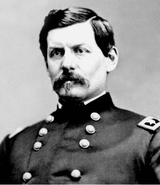1864 United States Presidential Election
|
|
|||||||||||||||||||||||||||||
|---|---|---|---|---|---|---|---|---|---|---|---|---|---|---|---|---|---|---|---|---|---|---|---|---|---|---|---|---|---|
|
|||||||||||||||||||||||||||||
|
All 233 electoral votes of the Electoral College 117 electoral votes needed to win |
|||||||||||||||||||||||||||||
| Turnout | 73.8% |
||||||||||||||||||||||||||||
|
|||||||||||||||||||||||||||||

Presidential election results map. light red denotes states won by Lincoln/Johnson, blue denotes those won by McClellan/Pendleton, and brown denotes Confederate states; two Confederate states (Louisiana and Tennessee) were controlled by the Union by 1864 and held elections (although their electors were not ultimately counted). Numbers indicate the number of electoral votes allotted to each state.
|
|||||||||||||||||||||||||||||
|
|||||||||||||||||||||||||||||
The United States presidential election of 1864 was the 20th quadrennial presidential election, held on Tuesday, November 8, 1864. In this match, incumbent president Republican Abraham Lincoln ran for reelection against Democratic candidate George B. McClellan, who tried to portray himself to the voters as the "peace candidate" who wanted to bring the American Civil War to a speedy end. The abolitionist John C. Frémont challenged Lincoln on the left as the Radical Democracy Party candidate but withdrew from the race in September. Lincoln was re-elected president by a landslide in the Electoral College.
Since the election of 1860, the Electoral College had expanded with the admission of Kansas, West Virginia, and Nevada as free-soil states. As the Civil War was still raging, no electoral votes were counted from any of the eleven southern states that had joined the Confederate States of America.
...
Wikipedia


